Deep Learning-Based Stroke Disease Prediction System Using Real-Time Bio Signals
Abstract
:1. Introduction
2. Related Works
2.1. Related Work on Stroke EEG
2.2. Related Work on AI-based Stroke Classification
3. Deep Learning-Based Stroke Disease Prediction System Using EEG
3.1. Sensor Device and Data Collection Module
3.2. Data Preprocessing Module
3.3. Stroke Prediction Module
3.3.1. Long-Short Term Memory (LSTM)
3.3.2. Bidirectional LSTM
3.3.3. CNN–LSTM
3.3.4. CNN-Bidirectional LSTM
4. Experiments and Result Analysis
4.1. Data Collection and Description
4.2. Performance Evaluation and Indicators for Experiments
- ① Sensitivity: Percentage of stroke patients who have tested positive.
- ② Specificity: Percentage of non-stroke patients who have tested negative.
- ③ False Positive Rate: Percentage of non-stroke patients who have tested positive.
- ④ False Negative Rate: Percentage of stroke patients who have tested negative.
- ⑤ Accuracy: Percentage of stroke patients determined as positive and non-patients as negative.
- ⑥ Precision: Percentage of people who are actually stroke patients among those who have tested positive.
- ⑦ Recall: Percentage of stroke patients who have previously tested positive.
- ⑧ F1-Score (Harmonic Mean of Precision and Recall): Percentage of stroke patients who have previously tested positive.
4.3. Experimental Results and Analysis
5. Conclusions
Author Contributions
Funding
Institutional Review Board Statement
Informed Consent Statement
Conflicts of Interest
References
- Mendelow, A.D. Stroke: Pathophysiology, diagnosis, and management. Elsevier Health Sci. 2000, 56, 275–286. [Google Scholar]
- Global Health Estimates. Geneva: World Health Organization. 2012. Available online: http://www.who.int/healthinfo/global_burden_disease/en (accessed on 1 June 2016).
- Feigin, V.L.; Forouzanfar, M.H.; Krishnamurthi, R.; Mensah, G.A.; Connor, M.; Bennett, D.A.; Murray, C. Global and re-gional burden of stroke during 1990–2010: Findings from the Global Burden of Disease Study 2010. Lancet 2014, 383, 245–255. [Google Scholar] [CrossRef]
- Roth, G.A.; Mensah, G.A.; Johnson, C.O.; Addolorato, G.; Ammirati, E.; Baddour, L.M.; Barengo, N.C.; Beaton, A.Z.; Benjamin, E.J.; Benziger, C.P.; et al. Global Burden of Cardiovascular Diseases and Risk Factors, 1990–2019: Update from the GBD 2019 Study. J. Am. Coll. Cardiol. 2020, 76, 2982–3021. [Google Scholar] [CrossRef] [PubMed]
- Hier, D.B.; Foulkes, M.A.; Swiontoniowski, M.; Sacco, R.L.; Gorelick, P.B.; Mohr, J.P.; Price, T.R.; Wolf, P.A. Stroke recurrence within 2 years after ischemic infarction. Stroke 1991, 22, 155–161. [Google Scholar] [CrossRef] [PubMed] [Green Version]
- Kummer, B.R.; Klang, E.; Stein, L.K.; Dhamoon, M.S.; Jetté, N. History of Stroke Is Independently Associated with In-Hospital Death in Patients With COVID-19. Stroke 2020, 51, 3112–3114. [Google Scholar] [CrossRef]
- Zhang, L.; Sun, W.; Wang, Y.; Wang, X.; Liu, Y.; Zhao, S.; Long, D.; Chen, L.; Yu, L. Clinical Course and Mortality of Stroke Patients with Coronavirus Disease 2019 in Wuhan, China. Stroke 2020, 51, 2674–2682. [Google Scholar] [CrossRef]
- Lee, K. Stroke Diagnosis. J. Korean Med. Assoc. 2002, 45, 1432–1439. [Google Scholar] [CrossRef]
- Lee, M.; Ryu, J.; Kim, D. Automated epileptic seizure waveform detection method based on the feature of the mean slope of wavelet coefficient counts using a hidden Markov model and EEG signals. ETRI J. 2020, 42, 217–229. [Google Scholar] [CrossRef]
- Acharya, U.R.; Oh, S.L.; Hagiwara, Y.; Tan, J.H.; Adeli, H.; Subha, D.P. Automated EEG-based screening of depression using deep convolutional neural network. Comput. Methods Programs Biomed. 2018, 161, 103–113. [Google Scholar] [CrossRef] [PubMed]
- Kim, D.; Kim, L. Detection of Early Stage Alzheimer’s Disease Using EEG Relative Power with Deep Neural Network. In Proceedings of the 2018 40th Annual International Conference of the IEEE Engineering in Medicine and Biology Society (EMBC), Honolulu, HI, USA, 18–21 July 2018; pp. 352–355. [Google Scholar]
- Chambon, S.; Thorey, V.; Arnal, P.; Mignot, E.; Gramfort, A. DOSED: A deep learning approach to detect multiple sleep micro-events in EEG signal. J. Neurosci. Methods 2019, 321, 64–78. [Google Scholar] [CrossRef] [PubMed] [Green Version]
- Kwon, Y.H.; Shin, S.B.; Kim, S.D. Electroencephalography based fusion two-dimensional (2D)-convolution neural net-works (CNN) model for emotion recognition system. Sensors 2018, 18, 1383. [Google Scholar] [CrossRef] [Green Version]
- O’Shea, A.; Lightbody, G.; Boylan, G.; Temko, A. Neonatal seizure detection from raw multi-channel EEG using a fully convolutional architecture. Neural Netw. 2020, 123, 12–25. [Google Scholar] [CrossRef] [PubMed]
- Özdamar, Ö.; Kalayci, T. Detection of Spikes with Artificial Neural Networks Using Raw EEG. Comput. Biomed. Res. 1998, 31, 122–142. [Google Scholar] [CrossRef] [PubMed]
- Wijaya, S.K.; Badri, C.; Misbach, J.; Soemardi, T.P.; Sutanno, V. Electroencephalography (EEG) for detecting acute ischemic stroke. In Proceedings of the 2015 4th International Conference on Instrumentation, Communications, Information Technology, and Biomedical Engineering (ICICI-BME), Bandung, Indonesia, 2–3 November 2015; 2015; pp. 42–48. [Google Scholar]
- Rahma, O.N.; Wijaya, S.K.; Badri, C. Electroencephalogram analysis with extreme learning machine as a supporting tool for classifying acute ischemic stroke severity. In Proceedings of the 2017 International Seminar on Sensors, Instrumentation, Measurement and Metrology (ISSIMM), Surabaya, Indonesia, 25–26 August 2017; pp. 180–186. [Google Scholar]
- Li, X.; Bian, D.; Yu, J.; Li, M.; Zhao, D. Using machine learning models to improve stroke risk level classification methods of China national stroke screening. BMC Med. Inform. Decis. Mak. 2019, 19, 261. [Google Scholar] [CrossRef] [PubMed]
- Adhi, H.A.; Wijaya, S.K.; Badri, C.; Rezal, M. Automatic detection of ischemic stroke based on scaling exponent electro-encephalogram using extreme learning machine. J. Phys. Conf. Ser. 2017, 820, 12005–12013. [Google Scholar] [CrossRef]
- Djamal, E.C.; Ramadhan, R.I.; Mandasari, M.I.; Djajasasmita, D. Identification of post-stroke EEG signal using wavelet and convolutional neural networks. Bull. Electr. Eng. Inform. 2020, 9, 1890–1898. [Google Scholar] [CrossRef]
- Schneider, A.L.; Jordan, K.G. Regional Attenuation WithOut Delta (RAWOD): A distinctive EEG pattern that can aid in the diagnosis and management of severe acute ischemic stroke. Am. J. Electroneurodiagn. Technol. 2005, 45, 102–117. [Google Scholar] [CrossRef]
- Finnigan, S.; Wong, A.; Read, S. Defining abnormal slow EEG activity in acute ischaemic stroke: Delta/alpha ratio as an op-timal QEEG index. Clin. Neurophysiol. 2016, 127, 1452–1459. [Google Scholar] [CrossRef] [PubMed] [Green Version]
- Varelas, P.N.; Hacein-Bey, L. Ischemic Stroke, Hyperperfusion Syndrome, Cerebral Sinus Thrombosis, and Critical Care Seizures. In Seizures in Critical Care; Springer Science and Business Media LLC, 2017; Volume 14, pp. 155–186. [Google Scholar] [CrossRef]
- Ip, Z.; Rabiller, G.; He, J.W.; Yao, Z.; Akamatsu, Y.; Nishijima, Y.; Liu, J.; Yazdan-Shahmorad, A. Cortical stroke affects activity and stability of theta/delta states in remote hippocampal regions*. In Proceedings of the 2019 41st Annual International Conference of the IEEE Engineering in Medicine and Biology Society (EMBC), Berlin, Germany, 23–27 July 2019; 2019; pp. 5225–5228. [Google Scholar]
- Kim, J.; Lee, B.; Lee, H.S.; Shin, K.H.; Kim, M.J.; Son, E. Differences in Brain Waves of Normal Persons and Stroke Patients during Action Observation and Motor Imagery. J. Phys. Ther. Sci. 2014, 26, 215–218. [Google Scholar] [CrossRef] [PubMed] [Green Version]
- Gautam, A.; Raman, B. Towards effective classification of brain hemorrhagic and ischemic stroke using CNN. Biomed. Signal. Process. Control 2021, 63, 102178. [Google Scholar] [CrossRef]
- Kalchbrenner, N.; Grefenstette, E.; Blunsom, P. A Convolutional Neural Network for Modelling Sentences. In Proceedings of the 52nd Annual Meeting of the Association for Computational Linguistics (Volume 1: Long Papers), Baltimore, MD, USA, 23–25 June 2014; Volume 1, pp. 655–665. [Google Scholar]
- Krizhevsky, A.; Sutskever, I.; Hinton, G.E. Imagenet classification with deep convolutional neural net-works. Commun. ACM 2017, 60, 84–90. [Google Scholar] [CrossRef]
- He, K.; Zhang, X.; Ren, S.; Sun, J. Deep residual learning for image recognition. In Proceedings of the IEEE Conference on Computer Vision and Pattern Recognition, Las Vegas, NV, USA, 27–30 June 2016; pp. 770–778. [Google Scholar]
- Chin, C.-L.; Lin, B.-J.; Wu, G.-R.; Weng, T.-C.; Yang, C.-S.; Su, R.-C.; Pan, Y.-J. An automated early ischemic stroke detection system using CNN deep learning algorithm. In Proceedings of the 2017 IEEE 8th International Conference on Awareness Science and Technology (iCAST), Taichung, Taiwan, 8–10 November 2017; 2017; pp. 368–372. [Google Scholar]
- Liu, L.; Chen, S.; Zhang, F.; Wu, F.-X.; Pan, Y.; Wang, J. Deep convolutional neural network for automatically segmenting acute ischemic stroke lesion in multi-modality MRI. Neural Comput. Appl. 2019, 32, 6545–6558. [Google Scholar] [CrossRef]
- Dourado, C.M., Jr.; da Silva, S.P.P.; da Nobrega, R.V.M.; Barros, A.C.D.S.; Reboucas Filho, P.P.; de Albuquerque, V.H.C. Deep learning IoT system for online stroke detection in skull computed tomography images. Comput. Netw. 2019, 152, 25–39. [Google Scholar] [CrossRef]
- Kabir, M.F.; Hossain, A.; Dahal, K. Enhanced classification accuracy on naive Bayes data mining models. Int. J. Comput. Appl. 2011, 28, 9–16. [Google Scholar] [CrossRef]
- Pal, S.K.; Mitra, S. Multilayer Perceptron, Fuzzy Sets, and Classification. IEEE Trans. Neural Netw. 1992, 3, 683–697. [Google Scholar] [CrossRef] [PubMed]
- Peterson, L.E. K-nearest neighbor. Scholarpedia 2009, 4, 1883. [Google Scholar] [CrossRef]
- Pal, M. Random forest classifier for remote sensing classification. Int. J. Remote Sens. 2005, 26, 217–222. [Google Scholar] [CrossRef]
- St, J.P.O.E.D.; Dumais, S.; Osuna, E.; Platt, J.; Scholkopf, B. Support vector machines. IEEE Intell. Syst. 1998, 13, 18–28. [Google Scholar] [CrossRef] [Green Version]
- Choi, Y.-A.; Park, S.; Jun, J.-A.; Ho, C.; Pyo, C.-S.; Lee, H.; Yu, J. Machine-Learning-Based Elderly Stroke Monitoring System Using Electroencephalography Vital Signals. Appl. Sci. 2021, 11, 1761. [Google Scholar] [CrossRef]
- Yu, J.; Park, S.; Kwon, S.-H.; Ho, C.M.B.; Pyo, C.-S.; Lee, H. AI-based Stroke Disease Prediction System Using Real-Time Electromyography Signals. Appl. Sci. 2020, 10, 6791. [Google Scholar] [CrossRef]
- Xie, Y.; Yang, H.; Yuan, X.; He, Q.; Zhang, R.; Zhu, Q.; Chu, Z.; Yang, C.; Qin, P.; Yan, C. Stroke prediction from electrocardiograms by deep neural network. Multimed. Tools Appl. 2021, 80, 17291–17297. [Google Scholar] [CrossRef]
- Fawaz, S.; Sim, K.S.; Tan, S.C. Encoding Rich Frequencies for Classification of Stroke Patients EEG Signals. IEEE Access 2020, 8, 135811–135820. [Google Scholar] [CrossRef]
- Mirza, M.; Osindero, S. Conditional generative adversarial nets. arXiv 2014, arXiv:1411.1784. 2014. [Google Scholar]
- Bebis, G.; Georgiopoulos, M. Feed-forward neural networks. IEEE Potentials 1994, 13, 27–31. [Google Scholar] [CrossRef]
- Zhang, S.; Zheng, D.; Hu, X.; Yang, M. Bidirectional long short-term memory networks for relation classification. In Proceedings of the 29th Pacific Asia Conference on Language, Information and Computation, Shanghai, China, 30 October–1 November 2015; pp. 73–78. [Google Scholar]
- Jeong, J.H.; Shim, K.H.; Kim, D.J.; Lee, S.W. Brain-controlled robotic arm system based on multi-directional CNN-BiLSTM network using EEG signals. IEEE Trans. Neural Syst. Rehabil. Eng. 2020, 28, 1226–1238. [Google Scholar] [CrossRef] [PubMed]
- Guntari, E.W.; Djamal, E.C.; Nugraha, F.; Liem, S.L.L. Classification of Post-Stroke EEG Signal Using Genetic Algorithm and Recurrent Neural Networks. In Proceedings of the 2020 7th International Conference on Electrical Engineering, Computer Sciences and Informatics (EECSI), Yogyakarta, Indonesia, 1–2 October 2020; IEEE: Piscataway, NJ, USA, 2020; pp. 156–161. [Google Scholar]
- Zhang, Q.; Benveniste, A. Wavelet networks. IEEE Trans. Neural Netw. 1992, 3, 889–898. [Google Scholar] [CrossRef] [PubMed]
- Giri, E.P.; Fanany, M.I.; Arymurthy, A.M.; Wijaya, S.K. Ischemic stroke identification based on EEG and EOG using ID convolutional neural network and batch normalization. In Proceedings of the 2016 International Conference on Advanced Computer Science and Information Systems (ICACSIS), Malang, Indonesia, 15–16 October 2016; 2016; pp. 484–491. [Google Scholar]
- Hochreiter, S.; Schmidhuber, J. Long short-term memory. Neural Comput. 1997, 9, 1735–1780. [Google Scholar] [CrossRef] [PubMed]
- Zaremba, W.; Sutskever, I.; Vinyals, O. Recurrent Neural Network Regularization. arXiv 2014, arXiv:1409.2329. [Google Scholar]
- Schuster, M.; Paliwal, K. Bidirectional recurrent neural networks. IEEE Trans. Signal. Process. 1997, 45, 2673–2681. [Google Scholar] [CrossRef] [Green Version]
- Wang, J.; Yu, L.-C.; Lai, K.R.; Zhang, X. Dimensional Sentiment Analysis Using a Regional CNN-LSTM Model. In Proceedings of the 54th Annual Meeting of the Association for Computational Linguistics (Volume 2: Short Papers), Berlin, Germany, 7–12 August 2016; 2016; Volume 2, pp. 225–230. [Google Scholar]
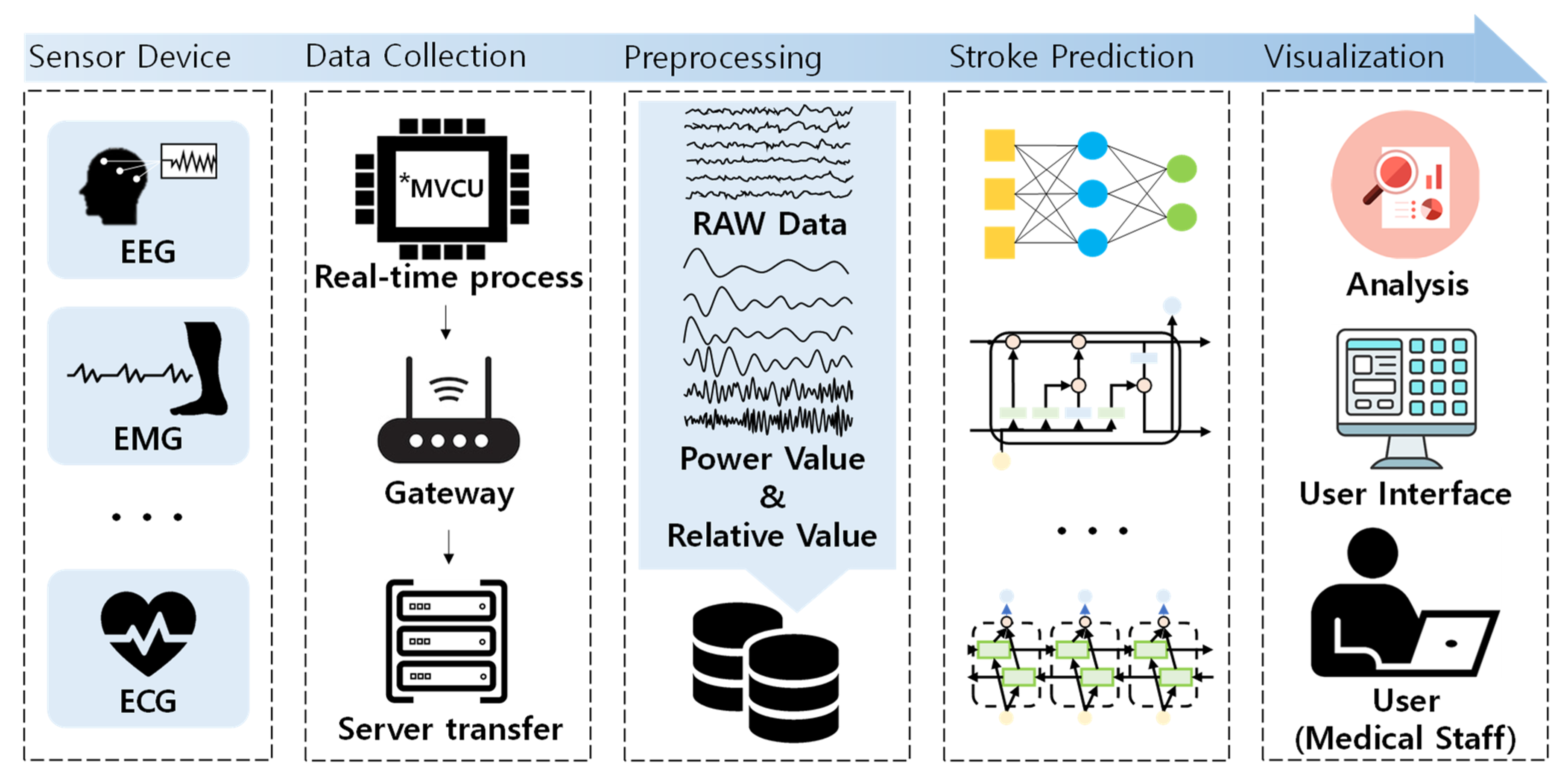
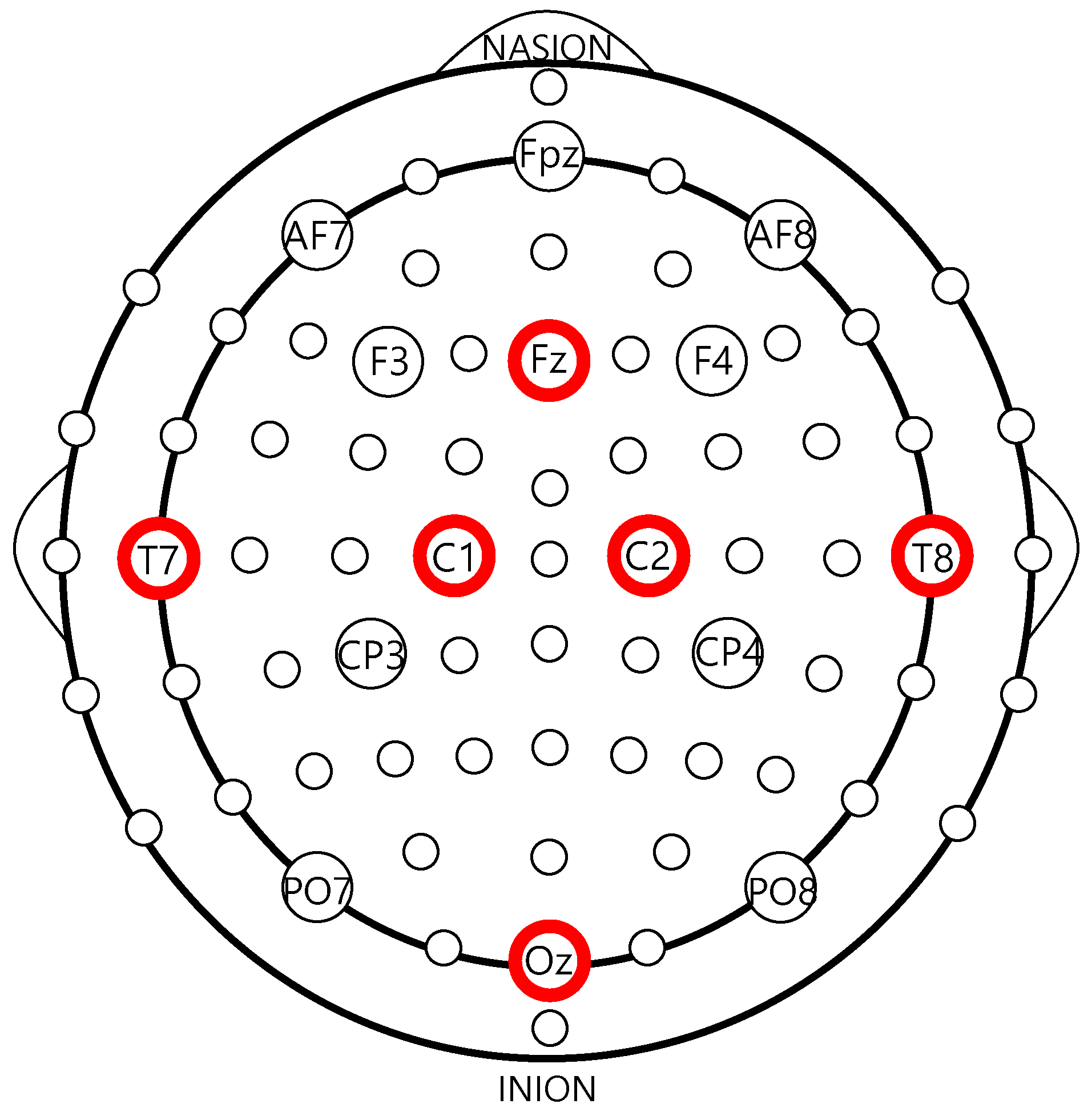
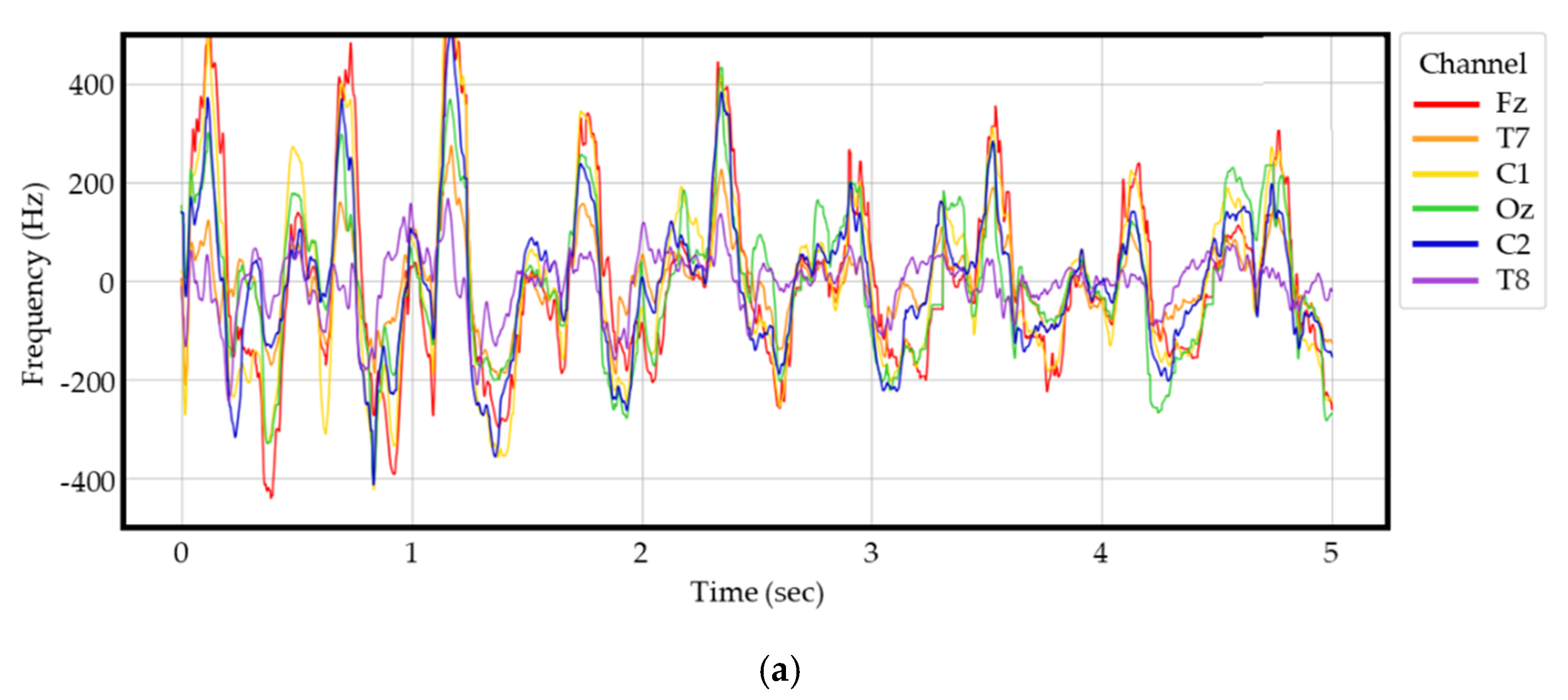
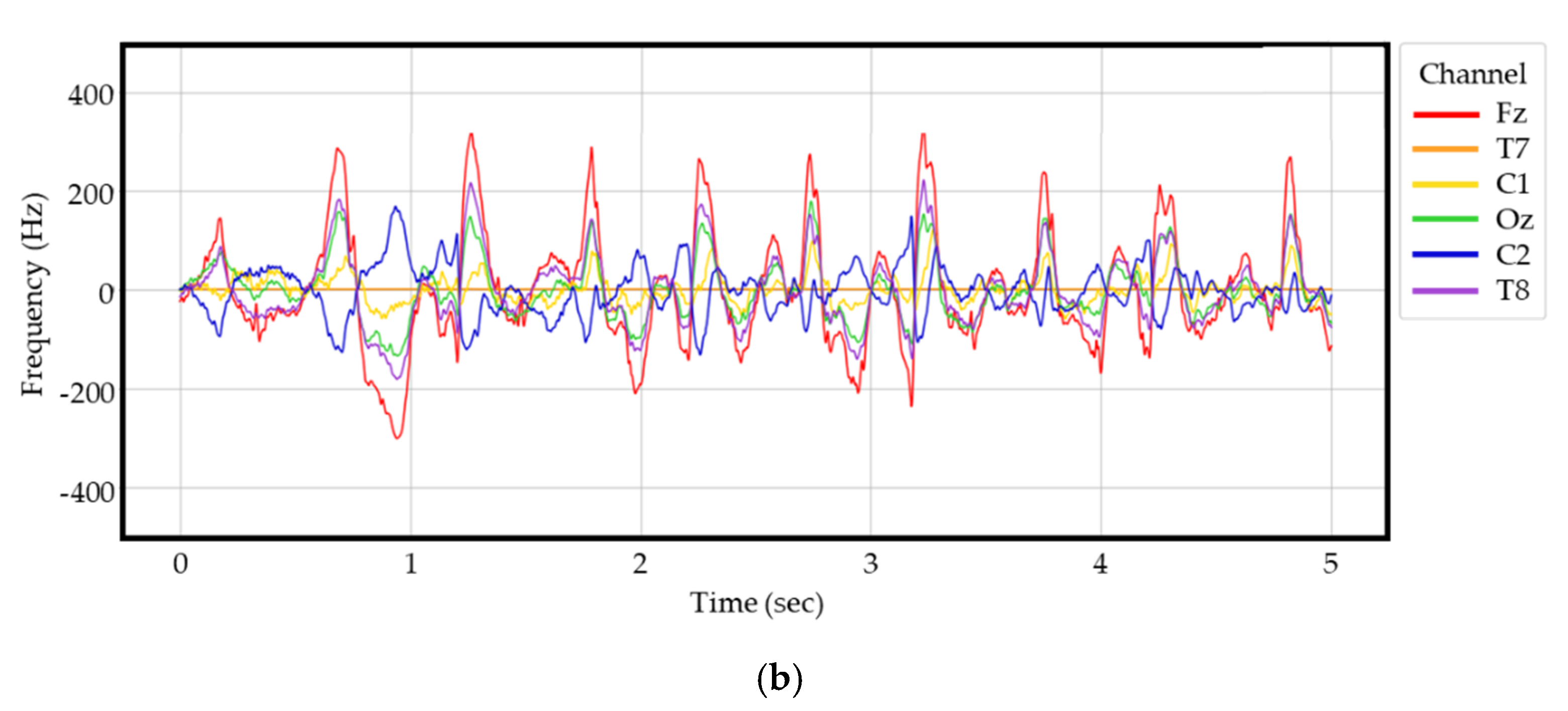
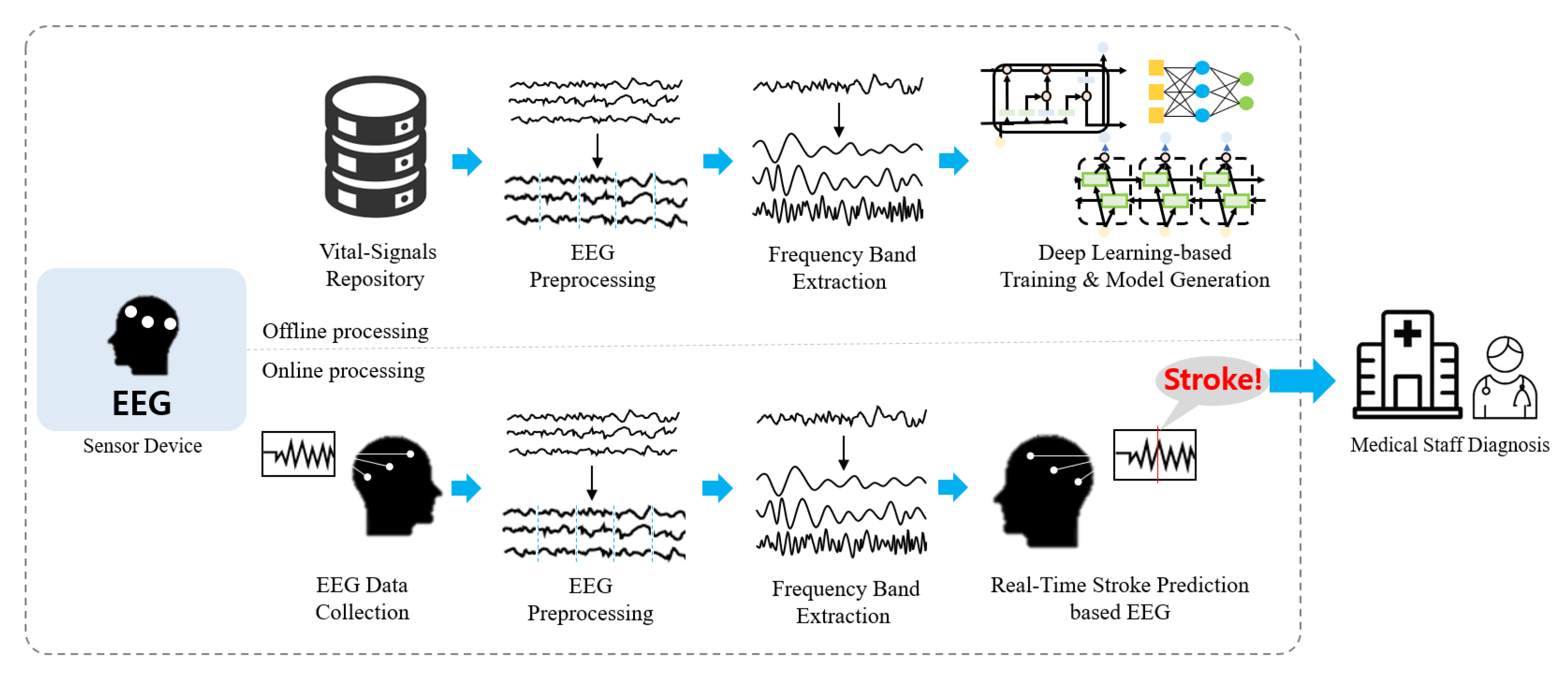
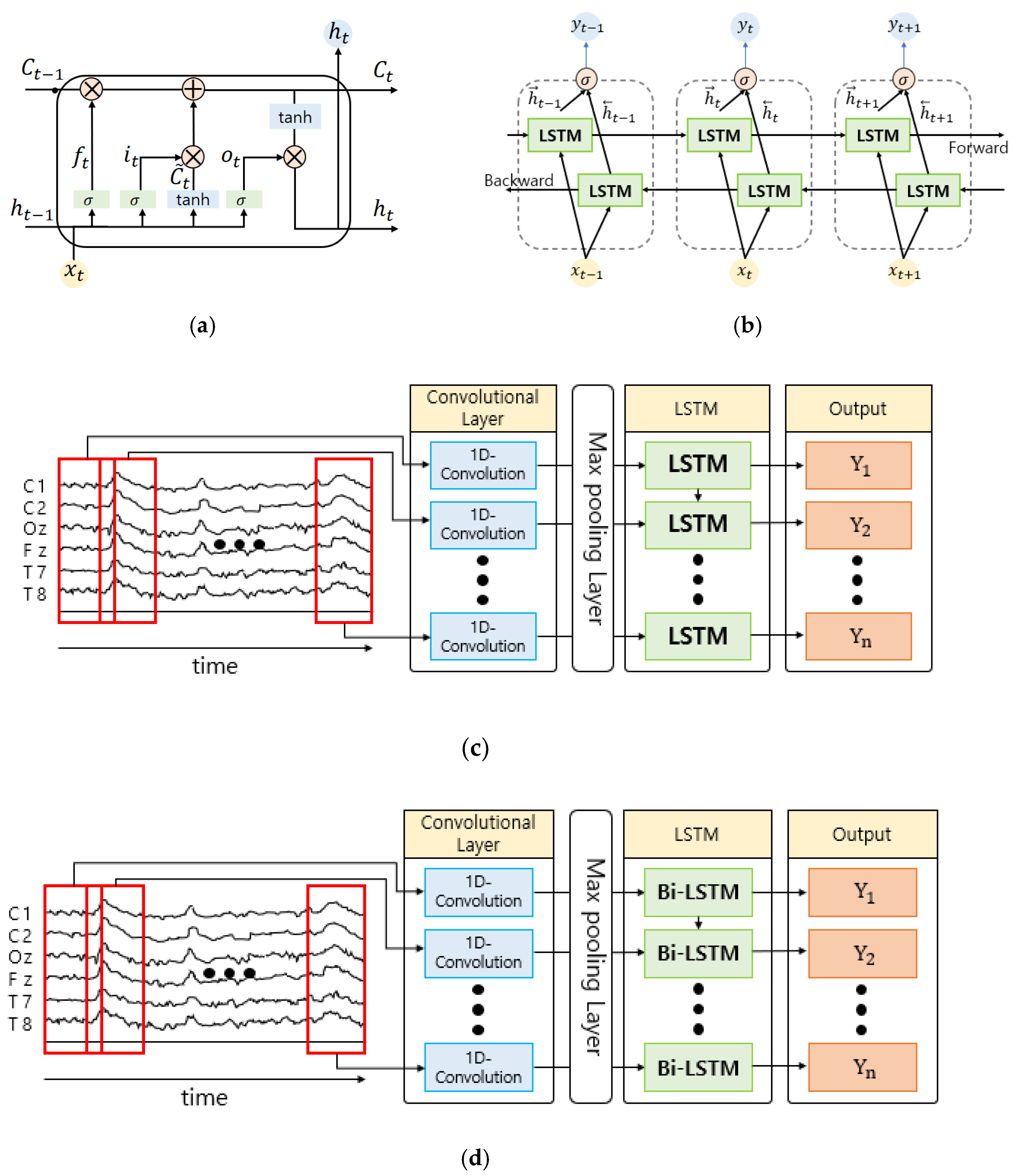

| Frequency Band | Meaning and Description |
|---|---|
| Delta | Delta power (1~4 Hz) |
| Theta | Theta power (4~8 Hz) |
| Alpha | Alpha power (8~13 Hz) |
| Beta | Beta power (14~30 Hz) |
| Gamma | Gamma power (30 Hz or more) |
| Low Beta | Low beta power (12~25 Hz) |
| High Beta | High beta power (25~30 Hz) |
| Theta to Beta | The value of the beta ratio in theta (extracting abnormal theta waves) |
| DAR | Ratio of mean power (delta/alpha) |
| IDAR | Inverse ratio of DAR (alpha/delta) |
| PRI | Power ratio index (delta+theta to alpha+beta), Low frequency to high frequency |
| True | Stroke | Normal | |
|---|---|---|---|
| Predicted | |||
| Stroke | TP 1 | FP2 | |
| Normal | FN 3 | TN 4 | |
| Evaluation Method | Models | Accuracy | Precision | F1-Score | |
|---|---|---|---|---|---|
| Data Sets | |||||
| Raw data | LSTM | 70.1 | 67.9 | 75.4 | |
| Bidirectional LSTM | 91.8 | 85.3 | 91.7 | ||
| CNN-LSTM | 93.7 | 96.6 | 93.7 | ||
| CNN-Bidirectional LSTM | 94.0 | 94.6 | 94.1 | ||
| Evaluation Method | Models | Sensitivity | Specificity | FPR 1 | FNR 2 | |
|---|---|---|---|---|---|---|
| Data Sets | ||||||
| Raw data | LSTM | 90.2 | 50.2 | 49.8 | 9.9 | |
| Bidirectional LSTM | 90.4 | 93.5 | 6.5 | 9.6 | ||
| CNN-LSTM | 91.9 | 96.1 | 3.9 | 8.1 | ||
| CNN-Bidirectional LSTM | 94.0 | 94.3 | 6.0 | 5.7 | ||
| Evaluation Method | Models | Accuracy | Precision | F1-Score | |
|---|---|---|---|---|---|
| Data Sets | |||||
| Power value | LSTM | 69.5 | 69.5 | 68.8 | |
| Bidirectional LSTM | 79.5 | 76.4 | 80.8 | ||
| CNN-LSTM | 74.7 | 71.4 | 77.3 | ||
| CNN-Bidirectional LSTM | 81.4 | 80.8 | 80.1 | ||
| Evaluation Method | Models | Sensitivity | Specificity | FPR | FNR | |
|---|---|---|---|---|---|---|
| Data Sets | ||||||
| Power value | LSTM | 73.8 | 64.2 | 35.8 | 26.2 | |
| Bidirectional LSTM | 88.3 | 70.8 | 29.2 | 11.7 | ||
| CNN-LSTM | 86.8 | 65.1 | 34.9 | 13.2 | ||
| CNN-Bidirectional LSTM | 82.7 | 81.5 | 18.5 | 17.3 | ||
| Evaluation Method | Models | Accuracy | Precision | F1-Score | |
|---|---|---|---|---|---|
| Data Sets | |||||
| Relative value | LSTM | 81.0 | 82.8 | 80.7 | |
| Bidirectional LSTM | 89.2 | 86.9 | 88.8 | ||
| CNN-LSTM | 84.0 | 82.4 | 83.7 | ||
| CNN-Bidirectional LSTM | 86.2 | 87.3 | 85.8 | ||
| Evaluation Method | Models | Sensitivity | Specificity | FPR | FNR | |
|---|---|---|---|---|---|---|
| Data Sets | ||||||
| Relative value | LSTM | 79.3 | 82.5 | 17.5 | 20.7 | |
| Bidirectional LSTM | 91.6 | 87.5 | 12.5 | 8.4 | ||
| CNN-LSTM | 85.2 | 87.3 | 12.7 | 14.8 | ||
| CNN-Bidirectional LSTM | 86.0 | 83.1 | 17.0 | 14.0 | ||
| Data Sets | Models | Learning Rate | Batch Size | Epoch | Optimizer |
|---|---|---|---|---|---|
| Raw | LSTM | 0.01 | 64 | 50 | Adam |
| Bidirectional LSTM | 0.001 | 128 | 100 | ” | |
| CNN- LSTM | 0.01 | 64 | 200 | ” | |
| CNN-Bidirectional LSTM | 0.001 | 64 | 500 | ” | |
| Power | LSTM | 0.0001 | 64 | 300 | ” |
| Bidirectional LSTM | 0.001 | 32 | 300 | ” | |
| CNN- LSTM | 0.01 | 128 | 500 | ” | |
| CNN-Bidirectional LSTM | 0.001 | 64 | 500 | ” | |
| Relative | LSTM | 0.0001 | 128 | 500 | ” |
| Bidirectional LSTM | 0.001 | 32 | 300 | ” | |
| CNN- LSTM | 0.001 | 64 | 300 | ” | |
| CNN-Bidirectional LSTM | 0.01 | 64 | 300 | ” |
Publisher’s Note: MDPI stays neutral with regard to jurisdictional claims in published maps and institutional affiliations. |
© 2021 by the authors. Licensee MDPI, Basel, Switzerland. This article is an open access article distributed under the terms and conditions of the Creative Commons Attribution (CC BY) license (https://creativecommons.org/licenses/by/4.0/).
Share and Cite
Choi, Y.-A.; Park, S.-J.; Jun, J.-A.; Pyo, C.-S.; Cho, K.-H.; Lee, H.-S.; Yu, J.-H. Deep Learning-Based Stroke Disease Prediction System Using Real-Time Bio Signals. Sensors 2021, 21, 4269. https://doi.org/10.3390/s21134269
Choi Y-A, Park S-J, Jun J-A, Pyo C-S, Cho K-H, Lee H-S, Yu J-H. Deep Learning-Based Stroke Disease Prediction System Using Real-Time Bio Signals. Sensors. 2021; 21(13):4269. https://doi.org/10.3390/s21134269
Chicago/Turabian StyleChoi, Yoon-A, Se-Jin Park, Jong-Arm Jun, Cheol-Sig Pyo, Kang-Hee Cho, Han-Sung Lee, and Jae-Hak Yu. 2021. "Deep Learning-Based Stroke Disease Prediction System Using Real-Time Bio Signals" Sensors 21, no. 13: 4269. https://doi.org/10.3390/s21134269
APA StyleChoi, Y.-A., Park, S.-J., Jun, J.-A., Pyo, C.-S., Cho, K.-H., Lee, H.-S., & Yu, J.-H. (2021). Deep Learning-Based Stroke Disease Prediction System Using Real-Time Bio Signals. Sensors, 21(13), 4269. https://doi.org/10.3390/s21134269







